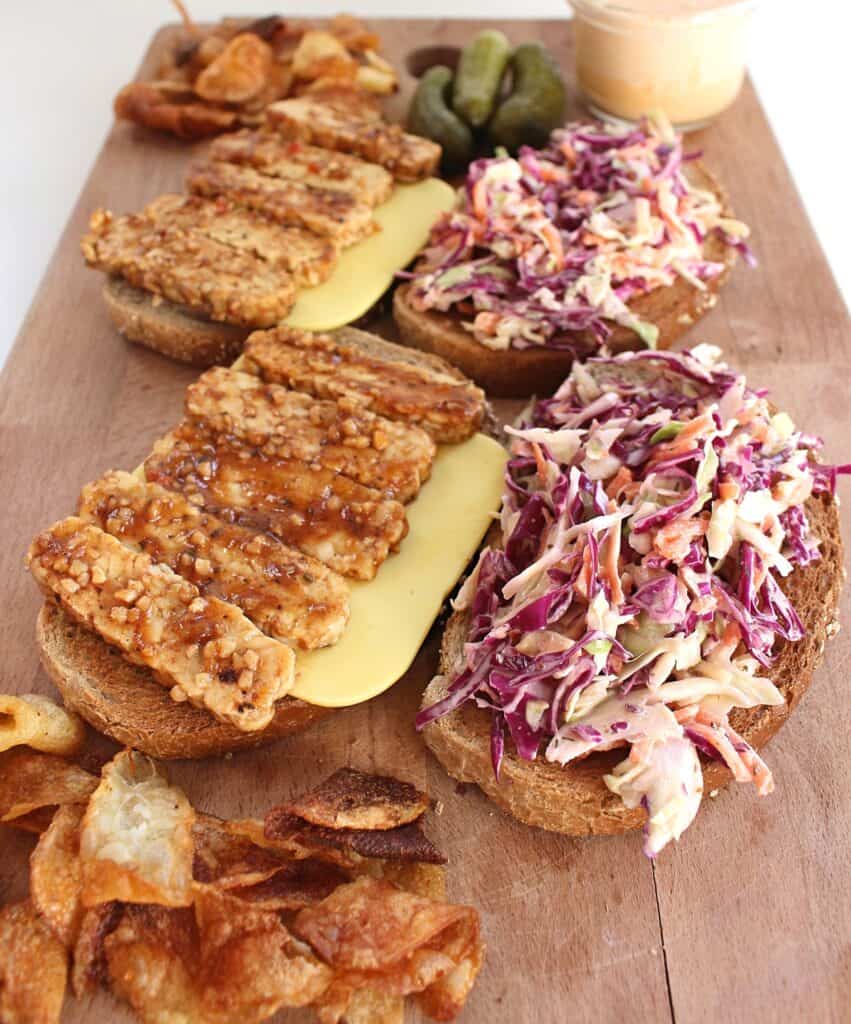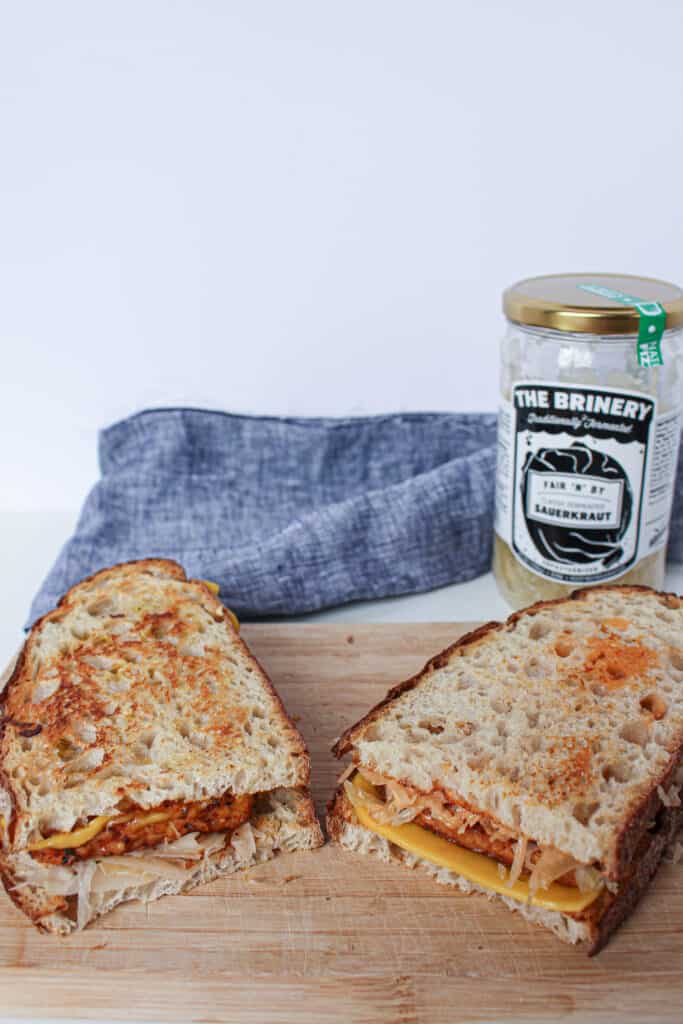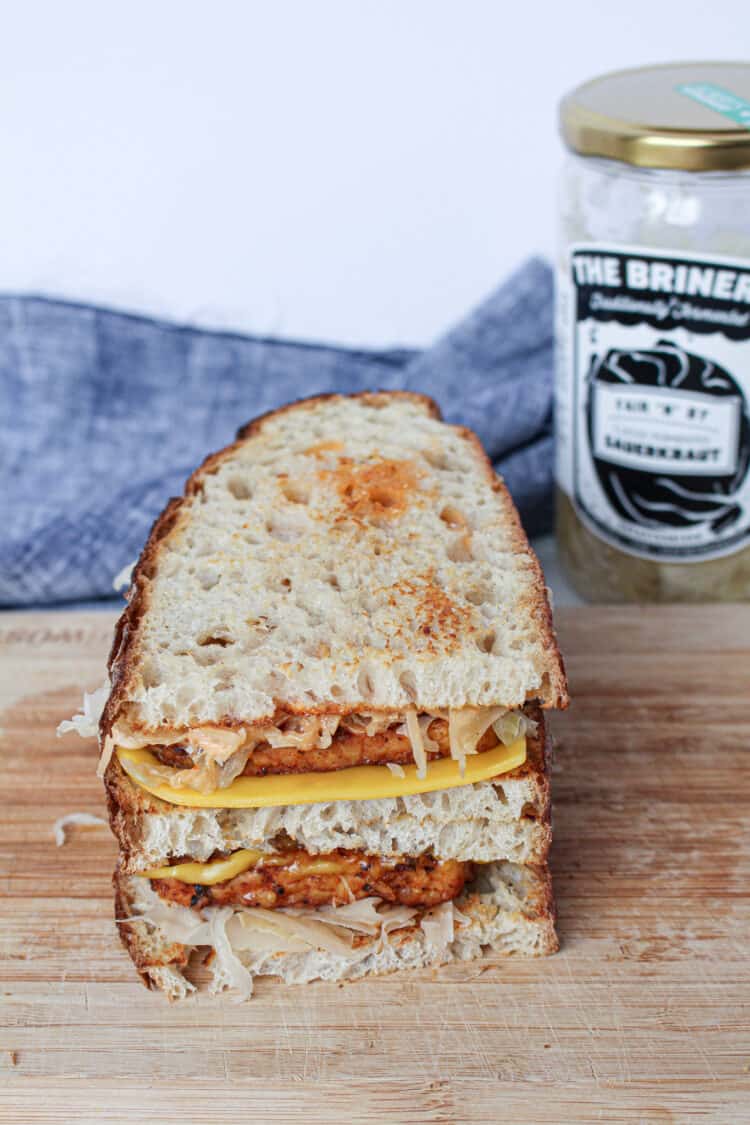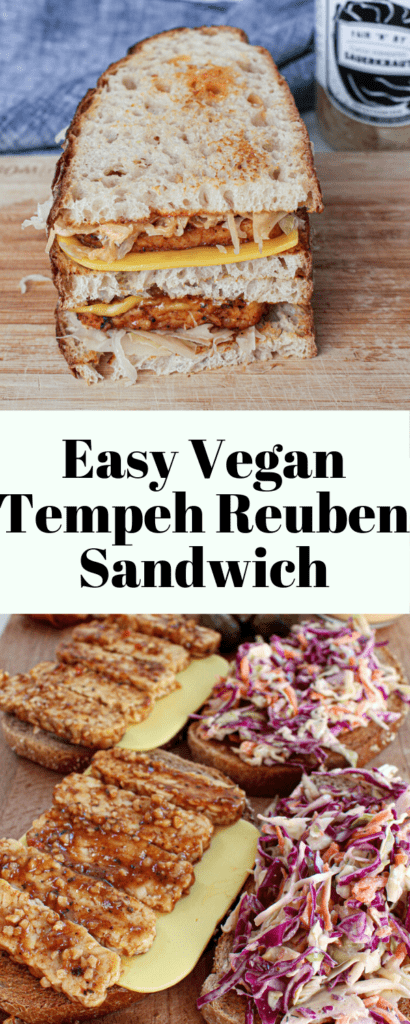
Let’s talk tempeh!
Today’s post is going to tell you everything you want to know about tempeh and ends with an easy vegan tempeh reuben sandwich recipe. Tempeh is a nutrient-dense soy product that is high in fiber, protein, vitamins, antioxidants and phytochemicals. The fermentation process involved in producing tempeh has shown to improve the nutritional value by enhancing several B-vitamins, iron, essential amino acids, fatty acid content. Additionally, the fermentation process removes antinutritional factors such as such as phytate, saponins, hemagglutinins, and antitrypsin that are present in soybeans.(1) Tempeh has a much firmer texture than tofu, which is also made from soy, making it a great option for sandwiches like this easy vegan tempeh reuben sandwich. On its own, tempeh has a mild nutty taste and it easily takes on various flavor-profiles with the use of different marinades, herbs, and spices. Quite versatile in cooking methods, tempeh can be baked, sautéed, or grilled. In addition to these reubens, you can crumble tempeh and use in place of meat in chili, soups, and tacos or marinate and serve in a salad, grain bowl, and stir-fry. Basically, the options are endless, and you should try this delicious plant-based protein!
This past year I was fortunate enough to work with a dietetic intern, Melissa Robinson, MPH who turned out to be a fermentation expert. Prior to starting her journey to getting her Master’s in Public Health and becoming a dietitian she worked as a Fermentation & Preservation Educator. Let me tell you, I had so many questions and Melissa has graciously agreed to provide some answers for us here!
- In short, how is tempeh made?
Tempeh is an Indonesian soybean ferment made by adding a culture to partially cooked soybeans and incubating for about 2 days. The culture, rhizopus oligosporus, is in the fungus family and actually grows around the soybeans during incubation, forming a “cake” as finished tempeh.
- What is the difference between store bought tempeh and fresh tempeh?
Without freezing or pasteurization, fresh tempeh spoils within a week of storage in the refrigerator. To prevent rapid spoilage, commercial tempeh is pasteurized for stability in the refrigerator. While pasteurization extends the shelf life of tempeh, the texture and flavor are altered. Fresh tempeh has a nutty, mushroom-like flavor with a much firmer texture. Some smaller companies like The Brinery in Ann Arbor, MI make “fresh-frozen” tempeh that is frozen to preserve the taste and texture rather than pasteurized.
- Does fresh tempeh require different preparation/cooking methods from the pasteurized options found in the grocery store? (i.e. can it be eaten straight out of the package or does it need to be cooked first)
One benefit of pasteurized tempeh is that it can be consumed right out of the package. Because fresh or fresh frozen tempeh has never been cooked via pasteurization, you do need to cook the tempeh in some way before consuming. Tempeh has never traditionally been eaten raw and it is not recommended to eat fresh tempeh without cooking.
- Can someone make tempeh at home? And if so, are there any resources you recommend for someone looking to make their own tempeh?
Making tempeh at home is possible, but can be an intense process requiring the purchase of a starter culture and an incubation system, which you can make using common household items like a cooler and hot water bottles. Because there is nothing quite like fresh tempeh as well as the satisfaction of making your own, I encourage anyone interested to try! In addition to the resources listed below, there are also various online forums and communities that discuss tempeh fermentation.
- Wild Fermentation & Art of Fermentation by Sandor Katz
- Cultures for Health (to purchase starter culture)
- Tempeh Demystified (online zine) by Fermentation on Wheels
- Are there any resources you recommend for someone who is looking to find fresh tempeh near them?
There are an increasing number of smaller companies selling fresh or fresh-frozen tempeh. Ask at your local farmers market, co-op, or health foods store, as these outlets sometimes work with smaller producers. Or search online for local/fresh tempeh to discover producers near you.
- What is your favorite way to use tempeh?
I love thinly sliced, fresh tempeh marinated in tamari, fresh ginger, and garlic lightly sautéed – it’s simple and excellent on salads, in a bowl or stir fry and even on a tempeh reuben.
- What is something most people don’t know about tempeh?
Tempeh can be made from a variety of “substrates.” Traditionally, tempeh is made from soybeans, but grains and other legumes and beans can also be used to make tempeh. What makes something tempeh is specific to the process and culture harnessed to transform the substrate. My favorite tempeh is made from a mix of soybeans and toasted sunflower seeds.
- Does tempeh contain pre- or probiotics?
Because tempeh is cooked before consumption, it does not contain living probiotics when consumed. However, it is full of prebiotics, high in fiber that feeds the “good” bacteria in your GI tract. Additionally, the tempeh culture essentially pre-digests soybeans, making it easier for your body to absorb the nutrients in the tempeh.
- How do you know so much about tempeh?
I worked at The Brinery, an artisanal food business in Ann Arbor, MI, for nearly four years, where I learned to make tempeh and developed their tempeh department. During this time, I had the opportunity to study fermentation with fermentation revivalist Sandor Katz as well as travel with Tara Whitsitt of Fermentation on Wheels. I also visited Barry’s Tempeh in Brooklyn, NYC to see his operation.
- What did your job look like at The Brinery ?
At The Brinery, I performed research and development on tempeh production, managing this department as well as improving production processes on a range of other fermented product lines, including hot sauce, sauerkraut, and beet kvass. The Brinery stopped making tempeh after I left to pursue a career in nutrition in 2017, but is currently in the process of relaunching tempeh production. I have been serving as a consultant for their relaunch.
Thank you Melissa for sharing all of this great info! You can connect with Melissa on Linkedin
If you want to geek out on more tempeh information, there is an entire chapter “Tempeh and Other Fermented Soybean Products Rich in Isoflavones” in the book Fermented Foods in Health and Disease Prevention
Hopefully you are currently feeling inspired to try tempeh. Start here by experimenting with this easy vegan tempeh reuben sandwich:
You can keep this reuben sandwich traditional and use sauerkraut which is always delicious.

Another variation that also does not disappoint, is to make it with coleslaw. I have made these reubens both ways and cannot choose a favorite. When I have used slaw, I used this creamy vegan coleslaw by connoisseurusveg as a guide.




Ingredients
16 ounces of Tempeh, thinly sliced
Rye bread, or bread of choice
Coleslaw or sauerkraut
Vegan cheese of choice, I used violife here
Russian or Thousand Island Dressing.
*You can make your own or there are several vegan options available for purchase.2 tbsp vegan butter like Earth Balance, melted (optional)
- Marinade Ingredients
1/4 cup Italian Dressing, bottled or homemade – up to you 🙂
1/4 cup A1 Sauce
1/2 tablespoon minced garlic
1/2 tablespoon dried basil
1/2 tablespoon liquid smoke
Directions
- Thinly slice the tempeh
- Mix all marinade ingredients together in a bowl or the container you plan to marinate the tempeh in.
*Tip: If you mix them in your marinade container you will have one less dish to wash (yay) - Add tempeh to container and pour in marinade or lid the container and flip upside down a couple times to spread the marinade evenly over all of the tempeh slices
- Place in fridge for at least 2 hours.
*Tip: Can be made a day in advance. This is typically what I do and think the flavors are better the next day. - Once tempeh has marinaded and you are ready to eat: Place tempeh on a parchment paper-lined baking sheet and bake in over for 10 minutes at 400 degrees
- Toasting Bread options:
1) You can toast bread in the toaster and skip adding vegan butter. Then build your delicious reuben with cheese, slaw or sauerkraut, and dressing
OR
2) Butter one side of each slice of bread. On the non-butter side spread dressing on each slice. Top half of the slices with cheese, tempeh, and sauerkraut or slaw. Top each sandwich with remaining slices of bread, dressing side down.
Heat a skillet over medium heat. Place sandwich in skillet and cook until golden and cheese is melted, 3 minutes per side.
Are you a sandwich lover? If so, we have something in common and you may also enjoy my: chickpea tuna salad sandwich.
References:
- Frías, J., Martínez-Villaluenga, C., & Peñas, E.R. (2016). Fermented Foods in Health and Disease Prevention.


